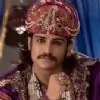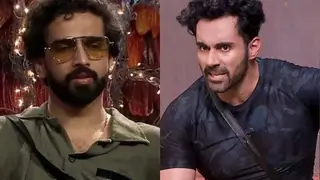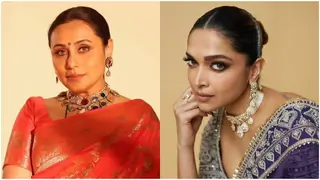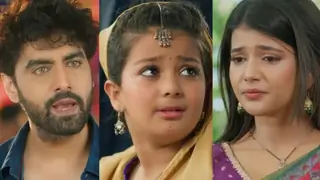Folks,
This time, I am covering only these 2 episodes, centred on the one key sequence, Jalal's (and Jodha's) visit to the Kali Maa mandir, because all else this week pales in comparison to its seminal significance .
The episodes that follow this might be interspersed with pleasant, and even charming interludes between our lead pair, but these are hardly as important as this segment. Important not only for the Jalal-Jodha relationship but, far more vital, for the epoch-making transformation of Jalal into Akbar. The transformation that fulfilled the blessings of two very different individuals; Maham: Duniya ke aasmaan mein hamare Jalal ka naam goonje!, and that of the priest at the Kali Maa mandir: Itihaas mein aapka naam sada maan sammaan ke saath liya jaaye. Shahenshah!
So let us begin with this wonderful sequence.
333 BC: Gordium. Phrygia: Alexander of Macedon, later to be called Alexander the Great, faces the incredibly complicated Gordian knot that had, for centuries past, tied an ox cart to a pole in the palace of the former kings of Phrygia, then a province of the Persian empire. An oracle had prophesied that the one to untie the knot would become the king of Asia.
Alexander surveys the knot, and realizing that no conventional methods would work, slices it in half with a single stroke of his sword, producing the required ends. This was the "Alexandrian solution" for the intractable problem of the Gordian knot.
The oracle's prophecy was fufilled, for Alexander did go on to conquer Asia as far as the Indus. But not India.
1562 AD: Amer, Rajputana: Shahenshah Jalaluddin Mohammed faces the statue of the Devi Maa in the Mahakali mandir near Amer, listening to his wife, Jodha. He turns to her, his eyes wide in incredulous shock- or is it dismay? - and repeats what she has just said was her only sankalp before the goddess: To aap hamara sar inke kadmon mein rakhna chahti hain?, and Jodha nods, imperceptibly.
It is more of a statement than a question, for by now, he knows his Jodha Begum. When he sees her eyes, normally serene after her pooja, clouded with tears of frustration, he is sensitive enough, and caring enough, to note it and to want (figuratively speaking) to wipe those tears away. When he learns the reason why, he does not fly into a rage, as most husbands would have done. For he instinctively understands that this is, for her, a matter of her salvation.
He turns away from Jodha and moves towards the huge statue of the Devi Maa, in her ugra kapalakundala roop, festooned only with floral garlands. He looks up at the Devi for a long moment, his eyes dark with both sadness and a troubled appeal.
The courage of his convictions: There is a perceptible hesitation, for no one should underestimate what this gesture costs him. What he is about to do would be taken as butparasti (idol worship), specifically forbidden in Islam. If anyone had spread the word across the Mughal sultanate that their Shahenshah had paid obeisance to a Hindu but, there would have been an uproar, and not only among the maulvis. Even decades later , when he had long been the all powerful Emperor Akbar, his initiative to found a syncretist religion merging Islam and Hinduism, the Din-e-Ilahi, had attracted widespread criticism. Now he is, as yet, nowhere near that level of unquestioned domination, so the risks are that much more.
Still, he does not hesitate, for in Jodha's troubled and angry gaze, he sees not just the woman whose acceptance he craves, even if only subconsciously as yet, whose barely veiled hostility hurts him like nothing ever before.
He sees the whole of the Hindustan that he wishes to unite under his rule, not by brute force,but thru willing acceptance. Na ki shamsheer ki dhar se, par rishton ke reshmi dhagon me piroke.To win the heart of this Hindustan, he knows now what he has to do. For them to accept him, he has first to accept them.
Jalal already has the breadth of spiritual vision, the inner clarity, that lets him see his Allah in the Devi. Not many even today, anywhere in the world, are able to do that, for all the current politically correct patter about accepting all religions. And in the 16th century, when Protestants and Catholics were massacring each other and burning each other at the stake all over Europe and in England, for the Emperor Jalaluddin Mohammed to demonstrate such purity of thought, such innate humanism, was nothing short of a miracle.
And this is not just because of Jodha, for even if she might have been the catalyst for this specific act of his, she is not the sole motivation for it. It is all about something infinitely bigger and grander, Jalal's vision for this vast land that he hopes to rule one day in peace and prosperity.
Epiphany: the Gordian knot untied:
Slowly, he goes down on his knees, his face once more upturned to the Devi's. There is the same questioning look, the mute appeal to Her. Is he asking Her whether She will accept him?
He bends down to the floor and pays obeisance to the Devi, his forehead at Her feet, and kisses the ground in the gesture of submission that is traditional for him. As he rises, his forehead is stained red with the kumkum.The Devi Maa has blessed him. His prayers have been answered. His sins, both those committed knowingly and those committed in his name, but unknown to him, have been forgiven.
In that one gesture of self-surrender to the Universal Divine, which he is able to perceive in the alien Devi Mahakali, in that act of submission to this Divine heedless of his ego, Jalaluddin Mohammed becomes Akbar.
All that followed in the years and decades to come was but the embellishment of the basic structure that was established in that single moment of epiphany.
The Gordian knot of incomprehension, of a sense of acute oppression, of discrimination, and of the resulting hostility and hatred, that divided Jalal, and the Mughal rule he embodied, from the Hindustan of his dreams was sliced thru as surely as the original one had been by Alexander's sword.
Jalal now turns to face Jodha, whose unblinking eyes are incredulous with. what? Amazement? Disbelief? His own are now serene and untroubled, reflecting the peace that now pervades his zehen, yet bright and lit with an inner conviction. Then he speaks:
Kisike kadmon par sar rakhne ke liye, sar kataane ki zaroorat nahin hoti, Jodha Begum. Sar jhukana hi kaafi hota hai!
Jodha: Angry incomprehension: Jodha, watching him with eyes that are still clouded with tears of angry frustration, does not understand the true import of his gesture. Of what he has done and why, or of what it has meant to him to do it. Imagination was never her strong point.
Jalal now approaches her with a happy smile of satisfaction and anticipation: Lijiye, humne aapki chahat aur aapki maangi hui mannat, donon poori kar di. Ab to khush ho jaayiye Jodha Begum! All thru the aarti by Jodha that follows, while Jalal takes in all these new impressions, his eyes still show that anticipation, that Jodha would, at last, be pleased with him for what he has done fo her. Alas, these hopes are to be dashed very soon!
Jalal tries again after the aarti is over: Ab to aapki khwahish bhi poori ho gayi hai, Jodha Begum.. And then comes the question that he has asked himself since he got to know that she hates him: Par humko samajh nahin aata ki aapko humse itni nafrat kyon hai? Kitni shiddat se aapne hamara sar inki kadmon mein rakhne ki kasam kha li?
That does it. The dam breaks, and out comes a torrent of angry accusations from Jodha. What she says , with a resurgence of furious tears, about the despoiling of the temple and the looting of the Devi Maa's sacred aabhooshan (jewellery) by the soldiers of "Shahenshah Jalaluddin", proves that she does not comprehend anything of his unprecedented gesture. For it is in the same hostile, bitter tone in which she was earlier mentioning her sankalp. The sense of dismay with which he asks : Kyon? Kisne kiya yeh, Jodha Begum? does not give her pause, for she never has ears for the nuances in what he says, not to speak of what he means but does not say.
In 2013, I had hoped that Jalal would clarify that he knew nothing of the outrage, and that he would gift new jewellery for the Goddess to make up for what was looted by his men, as a gesture of both apology and prayaschitta. That he would be hailed for this by the vast majority of the Rajputs, and that this would mark the beginning of the success of Akbar's strategy for Rajputana. A strategy that bore rich fruit during the rest of his long 49 year reign. None of this happened, of course, which was a pity.
The other Gordian Knot: By all logic, what Jalal does at the Mahakali mandir and after should cut thru the other Gordian knot, the one in Jodha's zehen. Cut thru the wall of mistrust, of acute, if now slightly blurred hostility towards the husband she is now saddled with that emerges at the slightest pretext. Hostility amounting to hatred, founded on the Jalal the Jallad image that she has nurtured, with and without justification, for years, and which she is now reluctant to abandon.
For what he does is also to free Jodha from the agony and frustration of being unable to fulfill the sankalp she had made to the Goddess. Being far more sensitive to her feelings than she is to his, he understands this perfectly, and finds an inspired solution to her dilemma that should both relieve her and earn her gratitude, if not her affection. Something of what he had hoped for does happen, but not the whole, not for a long while.
There are several othere aspects of this segment that merit analysis. .
Moral responsibility: Jalal does not defend himself to Jodha now not because it was some uniquely horrible incident, but rather because, even if he did not know about it, much less authorise it, the buck stops with him as the Shahenshah, and he is morally responsible for anything wrong done by his soldiers. Characteristically, he does not fudge that responsibility.
It is this sense of moral responsibility that fuels Jalal's anger at the existing state of governance in the Mughal sultanat that allows such outrages to happen. In his session with Atgah Khan after the mandir visit, he is exasperated at the distortion of information about events before it reaches him, because of which duniya humein apna sab se bada dushman samajhti hai! He brushes aside Atgah's explanation that this sort of thing happens everywhere: Par yeh hamari sultanat mein nahin hoga, Atgah Saheb!.. Agar ek sipahi bhi naajayaz loot karta hai, to riyaya use badshah ka farman samajhti hai!
Jalal's sense of frustration at the whittling away, because of such lawlessness, of his grand strategy of co-opting the Rajputs into the Mughal empire surfaces strongly: Hum bahut pareshan hain, Atgah Saheb!Yahan aakar humein maloom hua ki yahan ke logon ke dilon mein hamare liye sirf aur sirf nafrat bhari huyi hai, aur yeh jaayiz bhi hai! Unka nuksaan hua hai, unhein takleef pahunchi hai. Aur is baat ke liye kahin na kahin hum zimmedaar hain aur aap bhi! Is pareshaani ko door karne ke intezaamaat kiye hain, Atgah Saheb !Is mamle ki jadh tak pahuncha jaye ki kaise, hamari ijaazat ke bagair mandiron ko loota jaata hai ( he realises that the attack on the Kali Maa temple could not have been a one shot affair)!
When Atgah pleads that this investigation will be carried out and corrective action taken to prevent any such incidents, but that the Shahenshah should be a little patient kyonki aap Amer main hain, Jalal's response hints at his worries about more skeletons tumbling out of the sultanat's closet: Yahi to mushkil hai, ki hum Amer mein hain!Aur na jaane kya kya jaanne ko milega yahan!
Jalal is clearly determined to work out and implement a plan to prevent recurrences of such outrages. Although how far that can be done in war time I do not know, seeing that even the Iron Duke of Wellington could not prevent his troops from looting and attacking women during the war against Napoleon in Spain, and we all know what was done to German women by the victorious Soviet and Allied troops in WW II. How many of his own soldiers can he execute before dissension sets in? He can of course try to reduce the incidence of such incidents to the maximum.
Jodha:Volcanic outburst: Secondly, let us dissect Jodha's violent outburst. It falls into 2 parts, one the despoilation of the Kali temple, and second the killing of the Ameri soldiers.
The looting of the Kali Mandir: Taking the first part, what I could not understand was Jodha behaving as if this kind of outrage was unknown in her knowledge of history, and thus uniquely traumatic. In fact it was the opposite. I live in Pune, and I have read original documents in the archives here about how much looting and pillaging used to go on all around even before the Mughals. Not all the Rajvanshi rulers were like Maharana Pratap or his father Maharana Udai Singh or, later, the magnificent Maratha king, Shivaji Maharaj. Some of them were pretty low specimens of humanity (a courtesy term when used for them) and they used to inflict these outrages on their own subjects.
Jodha would surely have heard some of these stories, unless her auditory apparatus has a filter set to cut off anything that does not have the word Jalal in it, like the trigger word activating an intelligency agency wiretap!😉
I am not surprised that she also assumes that Jalal must have personally authorised the raid on the temple. Moti once tried to point out to her, long before he came into the picture with his secret descent on Amer, that he might have known nothing about such things done in his name. Jodha dismissed the idea out of hand then, and obviously would do the same now. As I noted elsewhere, imagination and perceptiveness are not her strong points
Next, about the Kali mandir attack being unexpected, and the Ameri soldiers having been caught unawares and thus killed. If this was so, why then the escort at all? In those day, real safety was only within your fortress walls, and there could have been dacoits, like those patronised by Sujanpur, even if there had been no Mughals. So why was Jodha's escort unprepared? That is something for which they should have been punished for slackness, as I did see any number of Ameri survivors after the Mughal raiders had been beaten off and Motibai rescued. Not lamented over as Jodha seems to be doing.
The deaths of Ameri soldiers: Actually, Jodha was not referring to that incident when she was talking about the burning pyres. She was referring to the battle with Sharifuddin, where the Amer army was defeated, for she clearly mentions their desire of Amer to retain its swatantrata aur swabhimaan. Now here, there are 2 points.
One, as her wonderful Dadisa points out, Amer was constantly coveted by a number of her more powerful Rajvanshi neighbours. If one of them had overrun and captured it, what about the Ameri soldiers who would have been killed then ? Would Jodha have felt better if her beloved Amer had been annexed by a Rajvanshi and not by a Mughal? Perhaps.
Two, assuming that it is the Mughal attack alone that is being considered, Jodha's rant about the burning pyres of the dead Ameri soldiers made no sense at all. Most of the Amer army was taken prisoner by Sharifuddin, not killed. In any case, Jodha, belonging to a warrior race, should have been familiar enough with wars and the war dead. She should also have studied, in her history lessons , how every Indian emperor from Chandragupta Maurya onwards built his empire, through wars for territory. Today, it was the Mughals, that was the only difference.
And if she is talking of the soldiers Jalal killed while he was escaping from Amer with the injured Abdul (whom I miss more than I can say!) if he had not killed them all, he could never have got away. So that part was nonsense. I anticipate future events here, but Jodha Begum displayed no such shock and horror when her Sujamal Bhaisa killed an even larger number of Mughal soldiers while escaping from the Agra palace, where he had been masquerading as a Khwaja Sera!
So, my point is that Jodha's carrying on as if Jalal had authorised and presided over some uniquely outrageous attack against the Kali mandir, and had then been the reason for the totally unwarranted war deaths of so many Ameri soldiers is completely illogical. She is talking, as usual, thru her hat, or rather her pallav.
NB: In 2013, Ela was surprised and disconcerted at Jodha taking her husband's name -Shahenshah Jalaluddin - even though this was clearly forbidden for Rajput wives. But it did not surprise me, for Jodha generally shows scant respect for her patidev, and it is not clear whether, at this stage, she sees him as her husband, except perhaps to lay claim to his Ammijaan, and be showered with gifts and coddled by her! Jodha Begum takes what she likes from the matrimonial package, and discards what she does not. It is that simple!😉 A 21st century feminist would say: Why not, if she can get it? Good for her! But if the Kali Maa had got to know what Jodha was like with her patidev, she would have consigned her to the Kumbhipak Narak reserved for those wives who do not observe their patni dharma!😉😉
If Jalal had been my son, I would have tried hard to make sure he stayed out of the clutches of this uncaring, self-righteous, overrated female, with her bhashanbaazi and her tantrums. But I doubt if I would have succeeded, for love, it seems, is deaf as well as blind!!😉
Illogical reasons, real pain: Despite the above, I would wish to make one strong point about Jodha's hatred against Jalal.
When a person is in pain, that pain might be due to the mental constructs and beliefs that he carries around with him. These constructs and beliefs may not be correct or justified. It can thus be argued that he should not perceive things the way he does, that he is being unreasonable in taking the stand he does, based on incorrect or faulty assumptions. Nonetheless, not only is the pain he feels real, but it is pain that only he can feel.
It is the same with Jodha now. She has, from the days when everyone around her, from her Bapusa to the Ameri soldier who describes the attack on the temple to her, has filled her mind with horror stories about the brutal, heartless Shahenshah Jalaluddin Muhammad, built up a mental construct about Jalal the Jallad. So she holds him personally responsible for the looting of the Kali Mandir, and for the Ameri deaths in the war against the Mughals. Her beliefs and her reactions are ill-founded and illogical - Motibai is far more clear-eyed and rational - but the pain she feels is real.
She hates Jalal also for her having been married off to him, whereas the truth is that the marriage was something her father arranged for his own interests and those of Amer, to reverse the fortunes of war, and Jalal cannot be blamed for it, at least not exclusively. But if she were to acknowledge the bitter truth - that her family, in effect, sold her to Jalal to save their own skins - she would collapse internally, and would have nothing to hold on to. So she demonizes Jalal and holds him responsible for everything bad that has happened to her.
Since she is no longer afraid of him, she tells him so as well: In sab wajahon se hum aapse itni ghrina karte hain! Ek bhi kaaran batayiye jis se hum aapse ghrina na karein?
Jalal: Empathetic understanding: Jalal needed to learn all that she blurts out to him, for this festering hatred is like a nasoor inside Jodha that had to be lanced and the poison inside drained if there was ever to be a healing.
Once she has told him why she hates him, even though the virulence of her outburst shocks him, he takes it on the chin and does not flinch. Earlier, as he listens to her performing the aarti to Kali Maa, his eyes are neither angry nor even frustrated. They are clear and empathetic, and later, dismayed and shocked but still understanding. For Jalal has both empathy and compassion, and he sees where his Jodha Begum is coming from.
His face remains deeply troubled till they leave. When the priest is giving Jodha his blessing:Sada suhagan raho! Tumhara sowbhagya sada bana rahe! Yashasvi putron ki maata bano! Jalal's eyes are not filled with gladness at the prospect of sons who will be renowned, for at this moment he can think of nothing but these unpleasant revelations.
Apart from his superlative take on Jalal cutting the Gordian knot, Rajat brings out both Jalal's concern for and empathy with his stubborn, angry wife, and his deep distress at the things he has learnt from her, with subtle skill.
It is now clear that when he was listening to the Mughal soldier's account of the looting of the temple, ( Jalal is then whirling like a dervish midway thru his jungi riyaaz), nothing had registered with him bar the references to the Registan ka gulab, and all this is new to him.The shock and distress in his wide open eyes when Jodha pours out her helpless rage and ghrina linger long after she has run down; the priest's blessings, for Jodha and then for him, pass unheard in the sounds of the inner turmoil in his zehen.
The butparasti trap: In 2013, very, very few in the forum, besides Ela and me, understood the seriousness of a potential charge of butparasti ( idol worship) against the Shahenshah, and what it could have meant for him. Almost everyone took it for granted as a minor gesture of broadmindedness. It was, politically speaking, anything but minor, not then, nor now either in very many rigidly theocratic countries.
Why, 120 years after this, Charles II of England confessed to being a Catholic only on his death bed, 20 years after he came to the throne in 1662! Even today, when we arrange Head of State or Head of Government visits to India, we are very careful about including any visits to places of worship. Think of, say, the Saudi King visiting the Meenakshi Temple at Madurai, or even a Shia or a Sufi shrine. No way!! I have never seen a leader of another religion visiting a Hindu shrine, though Western leaders go to the Golden Temple at Amritsar. And this is as much a matter public feelings back in their countries as of their personal feelings against such visits to shrines of other religions.
In 1562, it was political dynamite, and if the fact that the Shahenshah had visited a Hindu temple and worse, paid obeisance to a Hindu but, had become widely known, not only the mullahs, but large numbers of his Muslim subjects too would have been up in arms. Even without modern communication techniques - without this becoming Breaking news on umpteen TV channels, and spreading like wildfire on Facebook, Twitter , Instagram and the like - the Shahenshah, on his return to Agra, actually faces a serious attempt by the mullahs ( instigated by Adham Khan) to dethrone him.
So we have to understand the seriousness of a potential charge of butparasti against Jalal if his sublime gesture, of matha tekhna at the Kali mandir, had become public knowledge, and what it could have meant for him, seeing that he was at this point of time nohere near as secure as, say, he had become as Akbar in 1590.
I was in fact surprised at Dadisa's suggesting that Jalal go along with Jodha to the mandir, for she could hardly have known that he would be so, to use a contemporary term. liberal, in fact Sufi.
Maham: Justified fears: Maham's anger at, as she sees, Jodha having coaxed Jalal to go to the temple with her, and to perform pooja there (now who could have told her that? Unless Jodha's maids had started gossiping about what Jalal did; one of them was visibly delighted at just the news of the bahut badi ghatna that the Shahenshah had accompanied Jodha to the mandir) is thus justified. When she yells at Jodha, after having hurled the tumbler of water away violently: Aapne kaam hi aisa kiya hai jiski wajah se hamara sukh chain chin gaya hai, it is less because of her acute dislike of Jodha, and far more because she fears for hamara beta Jalal.
Maham initially refuses to even believe Resham's news about the temple visit ; once it is confirmed, she has nightmare visions of Jalal being called to account by the maulvis and the ulema for being not just being too accommodating towards the kaafirs, but actually participating in their butparasti.
This fear of hers is genuine (and she does not know that this is exactly what her son Adham is planning for Jalal as soon as he reaches Agra), for she is a politically shrewd adviser. Bairam Khan, had he been around, would have reacted in exactly the same way. These are all khattar Central Asian Sunnis, not Sufis, with their gentle syncretism and broad tolerance.
While I detest Maham for any number of reasons, here, what she is saying makes perfect political sense. It would, if the full story had been leaked, have played straight into the hands of Jalal's enemies within his own camp.
Jalal surely knows that, and he takes a calculated risk. My assessment is, as I have said above, that it was not solely to quiet the turmoil in Jodha's zehen. It was for a vastly larger purpose, of winning over all of Hindustan and making it accept him by first accepting it, and respecting its faith and its beliefs.
It was only incidentally about Jodha, and more about Jalal morphing into Akbar. And Rajat brought that alive on screen with a sureness of touch and a gift for emotional nuance that was a feast for the eyes.
NB: I wondered if Jodha took in anything of what Mahaam yelled at her about the risks to Jalal from the temple visit. It did not seem so. For a princess born, she is strangely blank when it comes to politico-military and siyasati realities. I suppose something did sink in, for she traipses over to their bedroom soon thereafter to question Jalal on this point.
Maham-Jalal: Persuasive eloquence: The same concerns dominate Maham's meeting with Jalal. What struck me there was Maham's body language, especially the grasping, clinging hands. She almost seemed to be feeling that he was slipping away from her, and she had to hold him back, and this for his sake as well as for hers.
Her arguments are full of affectionate concern and uncontestable logic: Shahenshah ke rutbe par lage hue zakhm kabhi nahin bharte..Itni badi galti kaise kar sakte hain Jalal? ..She stresses that she knows how deep is his love for his mazhab, Par aise kaam hi kyon karte hain jis se sawaal uthe, maulvi aur ulema ko lage ki aapko apne mazhab par yakeen nahin hai?
As for Jalal, his eyes bright and conveying a candid sincerity, his hands firmly grasping Maham's, he coaxes and reassures her by turns about his unshakeable commitment to Islam, and explains, with admirable fluency and conviction, the solid raisons d'etat (reasons of state) for his doing all that he has done of late, including his visit to the temple.
Amidst the welter of his words, and because of the affection and respect he shows her, culminating in his kneeling at her feet, kissing her hands, and twinkling up at her with dancing eyes, even the redoubtable Maham is disarmed. She concedes that as his Wazir-e-Aaliya, she cannot oppose his thinking, and as his Badiammi, she can only pray for his glory to be unrivalled the world over.
In all this, even Maham , with a mind as sharp as a steel trap, misses the obvious discrepancy in the two halves of Jalal's justification for his temple visit.
The first is that because Jodha Begum (though being a Hindu) had shown badappan in accompanying him to Ajmer Sharif, he too had been obliged, as the Shahenshah, to show badappan in his turn and visit the mandir. Yakeen rakhiye, hamara ek hi maqsad tha, Badiammi, unki Dadisa ki baat rakhna!
As Maham continues to protest vigorously, stressing that if the ulema were to feel that aap apne deen, apne mazhab, apne imaan se bhatak gaye hain, to humein bardasht nahin hoga Jalal!, he produces the second half of his justification, the purely political one.
Mughal sultanat ko bulundiyon par dekhna hamara farz hai.. That the earlier rulers who had tried to rule the whole of Hindustan had all failed. Wajah? Unhon ne is mulk ki sirf zameen par hukumat ki...All that he had done of late, including arranging Jodha Begum's sister Sukanya's marriage in their own community, had been for only one reason. Isi wajah se hum Amer aaye. Isi wajah se hum aaj mandir gaye, taki hum inke dil aur dimaag par raaj kar sakein!
He favours his Badiammi with a wide, dazzling smile while she, visibly softened and, even if reluctantly, persuaded to go along with him, looks at him with obvious, indulgent affection and concedes: Aapne jo kuch bhi kiya, soch samajh ke hi kiya hoga!
After watching Jalal in action, whether with Ruqaiya in Agra or with Maham in Amer, I can only repeat what I wrote earlier, about " how adept Jalal was becoming, astonishing in such an alpha male who claims he finds it difficult to understand his begums, in handling all the very different women in his life, Maham included. And he does this not by blunt commands, but by finessing his equation with each expertly, so as not to bruise the relationship seriously, and if possible at all, while still getting his own way and disregarding what each wants. If this means that he has to dish out plausible, not lies, but half-truths, who shall blame him? Even an emperor seeks, like any other male of the species, to avoid domestic discord!"
Jalal: Latent greatness: Lastly, the Jodha ne Jalal ko haivaan se kaise banaya insaan mantra might be trotted out ad nauseum in this show, but let us not fall into that highly misleading pit along with them. Jalal always had greatness in him, and once he was freed of his Khan Baba's harsh maxims, he came into his own .
Jalal was never a small man.
Not when he almost killed Adham in Malwa for atrocities against the common people there, and insisted that as soon as a region has been conquered and forms part of the Mughal empire, all its residents are entitled to equal protectio thru Mughal justice.
Not when he went against Bairam Khan to get justice for Raja Takhatmal. Not when he freed the parents of that little Hindu boy out of sheer compassion.
It was not a small man who knelt in front of an alien goddess, saw his Allah is that ugra kapalakundala Devi Maa, and risked the charge of butparasti (idol worship) not only to try and bring closure to Jodha's evident agony of soul over her failed sankalp, but also because, as I wrote above, "He sees the whole of the Hindustan that he wishes to unite under his rule, not by brute force,but thru willing acceptance. Na ki shamsheer ki dhar se, par rishton ke reshmi dhagon me piroke.To win the heart of this Hindustan, he knows now what he has to do. For them to accept him, he has first to accept them"
Jalal did not need the grief and tears of the woman he cares for to make him react to such an outrage by his men. The only thing Jodha did there was to let him know that this outrage had been committed, something of which he was till then unaware. If he had known of it, he would have acted immediately to set it right. She thus acts as a public grievance system. He does not react now because the sense of outrage is Jodha's. He would have done the same if it had been that little Hindu boy who briefed him about the temple looting.
In the transformation of Jalal into Akbar, there were many catalysts, and Jodha was one of them. But not even the most effective catalyst can trigger a chemical reaction if the basic ingredients are not already present. And then there are some chemical reactions that are auto-catalysed, as with Jalal a good part of the time, beginning with the breakneck 16 day ride to Malwa to save Baz Bahadur's former subjects from Adham Khan, which had nothing to do with Jodha.
Now let us, finally turn to what, in the days when I was a serving diplomat, we used to call bilateral issues.
Jalal & Jodha: Veiled bitterness: The abundance of Jalal-Jodha bickering - her endless applications of lep (there must have been an acute shortage of the concerned jadi booti in the whole of Hindustan by now! 😉) to a clothed and then a bare chested Jalal (I will refrain from any reference to the pressing need for Rajat to acquire greater muscle definition😉😉, but I could not understand the need to take off his tunic for applying lep to the back of his neck!), the head massage - was all more or less predictable and pleasant, without setting whatever river flows thru Amer on fire.
Jalal's crack about the Shahenshah ki izzat ko .. arms half folded across his chest like a Hindi film heroine in danger😉 - had me in stitches. It was even better, and decidedly naughtier, than the one about the bichchoo and saanp the night before.
But what struck me, in all this relentless, mischievous, flirtatious badinage from Jalal's side, was the periodic surfacing of a very evident bitterness. It is there when he says, offhandedly and seemingly in fun:
Aap jab bhi hamare pas aati hain to aapko koyi zaroori baat hi karni hoti hai..
Chaliye, isi bahane aapne hamein bahadur jangbaaz to samajha..
When she has, with pleading eyes fixed on his face, finished making an unprecedented vinati - at that word, Jalal's eyes show both surprise and a hint of gladness - that he should not fight with Kunwar Pratap, his eyes and voice are openly ironic: To yeh baat hai! Aur humein ek pal ke liye laga ki hamari begum ko hamari fikar ho rahi hai! Jodha looks, predictably, blank.
He goes on: Par aapko to aapke walid sahib ki fikar hai! Jodha continues, as if he had not said anything at all , to expatiate on how much she loves her Bapusa. His eyes now open wide in mock astonishment: Khuda ka shukr hai aap kisise to mohabbat karti hain, Jodha Begum! Koyi to hai jo aapse mehfooz hai!
And then at the Kali mandir, Jab aap saath hon, to hamein kisi aur se khatra kaise ho sakta hai? Aur phir kuch ho gaya to, aapko marham banana to aata hi hai!
She listens to all of this half resentfully, half in resignation, but she is deaf to the undercurrent beneath his jibes. Deaf to his unspoken need for her, not to love him, but to care for him, for what happens to him. If not as much as she cares for her family, at least some fraction thereof .
The day she begins to hear that unspoken plea, that will be the day their relationship will leave behind all this juvenile bickering, and will, finally, grow up .
Jalal has already come far more than halfway to meet her. Now it is up to her.
Rating for the whole, long Jalal-Jodha Scene No. 3, in his hoojra: 7/10.
Of which 5 are for the opening plea by Jodha and Jalal's reaction to it. The rest is pure chichoranpan, interspersed with the new leit motif, Jalal referring to Jodha as a baaghin: Pata nahin, Jodha Begum, jangal ko hamare saath kya bair hai!Pehle saanp, phir bagh, aur ab baaghin! And Jodha does not let us down, for she reacts to this crack with a perfect imitation of Asha Parekh stomping off after a tiff with Shammi Kapoor in Teesri Manzil!😉
Bye for now, folks. I hope to be back on Monday, covering the 4 episodes from Thursday to Sunday. With Zee Anmol now going to telecast Jodha Akbar 7 days a week, I shall be really hard put to keep pace with them. The only way out, if I am not to collapse, will be to omit the less significant parts, and at times episodes, as I used to do even in 2013.
Shyamala/Aunty/Akka/Di
Footnote: The K word: K is for kaafir, or unbeliever. In 2013, Maham was roundly reviled for hating kaafirs per se, of course she does. My point, then and now, was and is that those days, this must have been the majority opinion among Jalal's Muslim subjects.
Hatred of the "other" can be racial. Anti-black feelingswere widespread in the US deep South till the 1960s/70s.Washington DC is right next to Virginia, which was part of the Confederacy in the Civil War, and in the 1960s, the clubs on Massachussetts Avenue NW, on which our Embassy is located, did not allow non-whites to enter. In the 1960s!!! That was colour and race, this was religion, and in India till it was outlawed after our independence, it was untouchability. It is always there, this contemptuous hatred for the "other".
The kangaroo courts for blacks in the deep South of the US were widespread till the mid-20th century, and there were public lynchings of blacks, witnessed by large crowds of whites in their Sunday best, carrying their small kids on their shoulders. Later, they sent picture postcards of these events to their friends, circling themselves in the picture to show that they were there. It was only in 1923 that the US Post banned such postcards.
When it was religious, as with the Spanish Inquisition, non-Catholics were subjected to "the question", a euphemism for being tortured on the rack, till they agreed to convert. If they did not, they were burnt at the stake. This was during the 15th and 16th centuries. At least the Mughals did not organize such auto da fes (burnings at the stake) for the kaafirs!
I am sorry if I have made you feel sick, but that is the way it was, and compared to that, Mughal rule even with Maham around was relatively mild. Moreover, one cannot condemn a 16th century Mahaam from 2013. It is the instinctive tolerance and acceptance of Hamida and Jalal that must have been the exception. Yes, there were Sufi pirs and the like, but the majority of the population would not have been anything like them. The kaafir term would have been common, and is far from extinct even today. It is used by many to refer to, say, the Ahmediyas, who have been declared to be non-Muslims in many countries.
It would have been the same, if to a lesser extent, in the other direction, I cannot think of many 16th century Rajputs who would have tolerated roti beti ka rishta with the Mughals, and this as much because of the religious angle as the political one.
Why talk of the 16th century? What about now, in the rigidly theocratic regimes, +where there is no freedom of worship thru a prayer meeting even in the privacy of your home? Our Embassies in those countries are constantly having to fight for our citizens who get embroiled in very serious trouble over such issues.

































30